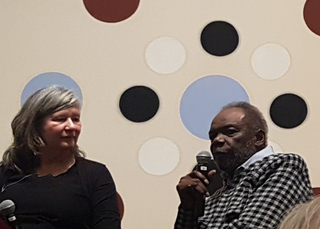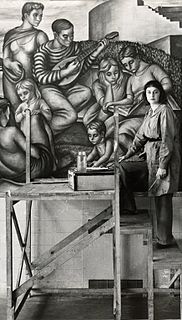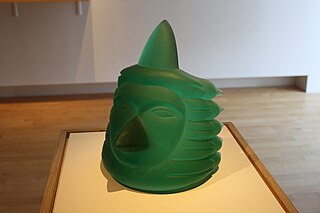Related Research Articles

Paul Howard Manship was an American sculptor. He consistently created mythological pieces in a classical style, and was a major force in the Art Deco movement. He is well known for his large public commissions, including the iconic Prometheus in Rockefeller Center and the Celestial Sphere Woodrow Wilson Memorial in Geneva, Switzerland. He is also credited for designing the modern rendition of New York City's official seal

Alexander Porfyrovych Archipenko was a Ukrainian and American avant-garde artist, sculptor, and graphic artist. He was one of the first to apply the principles of Cubism to architecture, analyzing human figure into geometrical forms.

The Cleveland Museum of Art (CMA) is an art museum in Cleveland, Ohio, located in the Wade Park District, in the University Circle neighborhood on the city's east side. Internationally renowned for its substantial holdings of Asian and Egyptian art, the museum houses a diverse permanent collection of more than 61,000 works of art from around the world. The museum provides general admission free to the public. With a $755 million endowment, it is the fourth-wealthiest art museum in the United States. With about 770,000 visitors annually (2018), it is one of the most visited art museums in the world.

William Zorach was an American sculptor, painter, printmaker, and writer. He won the Logan Medal of the arts. He is notable for being at the forefront of American Artists embracing cubism, as well as for his sculpture.

Sam Gilliam is an African-American color field painter and lyrical abstractionist artist. Gilliam is associated with the Washington Color School, a group of Washington, D.C. area artists that developed a form of abstract art from color field painting in the 1950s and 1960s. His works have also been described as belonging to abstract expressionism and lyrical abstraction. He works on stretched, draped and wrapped canvas, and adds sculptural 3D elements. He is recognized as the first artist to introduce the idea of a draped, painted canvas hanging without stretcher bars around 1965. This was a major contribution to the Color Field School.
Philip Pearlstein is an American painter best known for Modernist Realism nudes. Cited by critics as the preeminent figure painter of the 1960s to 2000s, he led a revival in realist art. He is a Distinguished Professor Emeritus with paintings in the collections of over 70 public art museums.
Richard E. DeVore, also written as Richard De Vore was an American ceramicist, professor. He was known for stoneware. He was faculty at Cranbrook Academy of Art’s Ceramics Department, from 1966 to 1978.
Toshiko Takaezu was an American ceramic artist, painter, sculptor, and educator who was known for her rounded, closed forms that viewed ceramics as a fine art and more than a functional vessel. She is of Japanese descent and from Pepeeko, Hawaii.
James Joseph Rorimer, was an American museum curator and former director of the Metropolitan Museum of Art, where he was a primary force behind the creation of the Cloisters, a branch of the museum dedicated to the art and architecture of Medieval Europe. During World War II, Rorimer served in the U.S. Army's Monuments, Fine Arts and Archives Section, a.k.a. the "Monuments Men," protecting cultural sites and recovering stolen art work.

Marion Greenwood was an American social realist artist who became popular starting in the 1920s and became renowned in both the United States and Mexico. She is most well known for her murals, but she also practiced easel painting, printmaking, and frescoes.
Fritz Dreisbach is an American studio glass artist and teacher who is recognized as one of the pioneers of the American Studio Glass Movement.

Anne Goldthwaite was an American painter and printmaker and an advocate of women's rights and equal rights. Goldthwaite studied art in New York City. She then moved to Paris where she studied modern art, including Fauvism and Cubism, and became a member of a circle that included Gertrude Stein, Henri Matisse, and Pablo Picasso. She was a member of a group of artists that called themselves Académie Moderne and held annual exhibitions.

Tom Joyce is a sculptor and MacArthur Fellow known for his work in forged steel and cast iron. Using skills and technology acquired through early training as a blacksmith, Joyce addresses the environmental, political, and social implications of using iron in his work. Exhibited internationally since the 1980s, his work is included in 30-plus public collections in the U.S. and abroad. Joyce works from studios in Santa Fe, New Mexico, and since 2012, in Brussels, Belgium, producing sculpture, drawings, prints, photographs, and videos that reference themes of iron in the human body, iron in industry, and iron in nature.

Paul Marioni is an American artist who works in the medium of glass.
Edris Eckhardt was an American artist associated with the Cleveland School. She is known for her work in Ceramic art and glass sculpture, her work with the Works Projects Administration's (WPA) Federal Arts Project of Cleveland, and her teaching.

Joyce J. Scott is an African-American artist, sculptor, quilter, performance artist, installation artist, print-maker, lecturer and educator. Named a MacArthur Fellow in 2016, and a Smithsonian Visionary Artist in 2019, Scott is best known for her figurative sculptures and jewelry using free form, off-loom beadweaving techniques, similar to a peyote stitch. Each piece is often constructed using thousands of glass seed beads or pony beads, and sometimes other found objects or materials such as glass, quilting and leather. In 2018, she was hailed for working in new medium — a mixture of soil, clay, straw, and cement — for a sculpture meant to disintegrate and return to the earth. Scott is influenced by a variety of diverse cultures, including Native American and African traditions, Mexican, Czech, and Russian beadwork, illustration and comic books, and pop culture.
Catherine Murphy is an American realist painter whose career began with the inclusion of her work in the 1971 Annual Exhibition of Painting and Sculpture at the Whitney Museum of American Art. A two-time recipient of the National Endowment of the Arts grant, Murphy has received numerous awards and honors for her work, including a Guggenheim Fellowship (1982) and most recently the Robert De Niro, Sr. Prize in 2013. She was a Senior Critic at Yale University Graduate School of Art for 22 years and is currently the Tepper Family Endowed Chair in Visual Arts at the Mason Gross School of the Arts at Rutgers.
Jolán Gross-Bettelheim (1900–1972) was a Hungarian artist who lived and worked in the United States from 1925 to 1956, before returning to Hungary.
Myra Mimlitsch-Gray is an American metalsmith, artist, critic, and educator living and working in Stone Ridge, New York. Mimlitsch-Gray's work has been shown nationally at such venues as the John Michael Kohler Arts Center, Museum of the City of New York, Metropolitan Museum of Art, Cooper-Hewitt Smithsonian Design Museum, and Museum of Arts and Design. Her work has shown internationally at such venues as the Middlesbrough Institute of Modern Art, Stadtisches Museum Gottingen, and the Victoria and Albert Museum, and is held in public and private collections in the U.S, Europe, and Asia.
Judith Weinshall Liberman is an Israeli artist who is known for the Holocaust Wall Hangings, a series of sixty loose-hanging fabric banners of varying sizes created between 1988 and 2002 depicting the plight of the Jewish people and other minorities during the Holocaust of World War II.
References
- 1 2 "Catherine Kernan | Smithsonian American Art Museum". americanart.si.edu.
- ↑ "Catherine Kernan Norman Stewart Traversal II, 1983". www.dia.org.
- ↑ "Cutaway II from the Artist's Proof Studio Archival Portfolio II, 2000". collections.mfa.org.
- ↑ "Sea Cleft #1". Cleveland Museum of Art. 30 October 2018.